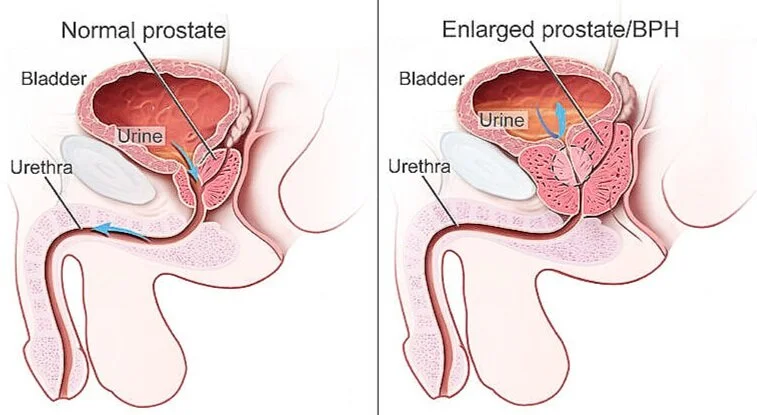Benign Prostatic Hyperplasia
About the Prostate
To understand BPH a little better, let’s talk about the prostate.The prostate is a small but important gland in the male reproductive system located deep inside the groin, between the base of the penis and the rectum.
As men age, the prostate can grow from the size of a walnut to about the size of a lemon. It’s not clear why the prostate grows like this, but it’s believed certain male hormones such as dihydrotestosterone tend to act more strongly on the prostate gland later in life*
Because the prostate is located just below the bladder, when it becomes larger it can place pressure on the urethra, the tube that carries urine from the bladder through the penis and out of the body.
About BPH
Benign prostatic hyperplasia (BPH) is a condition in which a man’s prostate becomes enlarged and obstructs the flow of urine. It causes frustrating symptoms including; frequent urination, weak, interrupted urine stream, difficulty starting and stopping urination, feeling a sudden urge to urinate, inability to urinate when needed, and lack of control over urination. While the exact cause is unclear, prostate growth is generally associated with aging as BPH becomes more common with age. BPH most commonly starts after 40 years of age. By age 60, half of all men will have an enlarged prostate. By age 85, the proportion reaches 90%.*
Diagnosis and Treatment Options
A doctor may do a number of things to find the cause of urinary problems, including: taking a medical history and description of symptoms; a physical examination; blood or urine tests; and sometimes ultrasound or digital rectal exam.** A wide variety of treatment options are available for BPH, including:
Behavioral modification, such as drinking fewer liquids before bed, drinking less caffeine and alcohol, or avoiding over-the-counter medications such as decongestants or antihistamines that can make prostate problems worse.
Medication may help to minimize symptoms or growth of the prostate when symptoms become more advanced.
Minimally invasive therapies like Rezum Water Vapor Therapy or GreenLight Laser Therapy are available when medication alone does not relieve symptoms of BPH, or when patients prefer not to take pills daily or experience medication-related side effects.
Surgery is sometimes necessary for larger prostates or medically complicated patients.
Medication is the most common first-line treatment for mild to moderate symptoms of prostate enlargement; however, minimally invasive or surgical therapy might be recommended if symptoms are moderate to severe, medication doesn’t relieve the symptoms, or the patient has other health issues.
Behavioral Modifications
Often when patients begin to experience lower urinary tract symptoms (LUTS) to the point where it is affecting their quality of life, the first step is to recommend behavioral modification. Some of the most common are reducing nightly fluid restriction, timed bladder voiding, avoiding caffeine, alcohol etc. These recommendations can sometimes be effective in reducing overall symptoms, but do not prevent the progression of the enlargement of the prostate.
Medication
If symptoms continue to increase in their severity, medication is typically the next step. There are several types/classes of medication that are used for the treatment of BPH. The two commonly prescribed medications are; Alpha blockers, and 5-alpha reductase inhibitors. It’s worth noting that medication does not do anything to treat the underlying cause of BPH, it just helps manage the symptoms in some cases.
Alpha blockers: This class of medications relax bladder neck muscles and muscles within the prostate, making urination easier. There are several types; tamsulosin, alfuzosin, terazosin, silodosin, and doxazosin. Common side effects include dizziness and retrograde ejaculation.
5-alpha-reductase inhibitors: These medications shrink the prostate by eliminating hormonal changes that cause prostate growth. The two most common are finasteride and dutasteride - these medications can take up to 6 months to be effective and can also cause retrograde ejaculation.
Minimally Invasive Therapies
There are several minimally invasive therapies available if medication doesn’t lessen the severity of BPH symptoms, the side effects of medication are intolerable, or a more definitive treatment option is desired to solve the underlying cause of the enlargement of the prostate.
Sources
*Harvard Health Publishing. “The growing problem of an enlarged prostate gland” https://www.health.harvard.edu/mens-health/the-growingproblem-of-an-enlarged-prostate-gland. McVary KT, Gange SN, Gittelman MC, et al.
**Urology Care Foundation. “How is BPH diagnosed?” https://www.urologyhealth.org/urologic-conditions/benign-prostatic-hyperplasia- (bph)/diagnosis?article=59.
